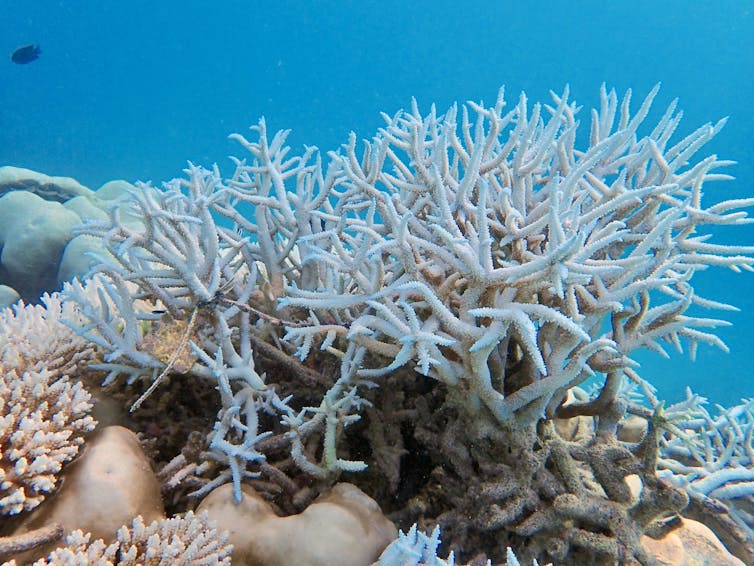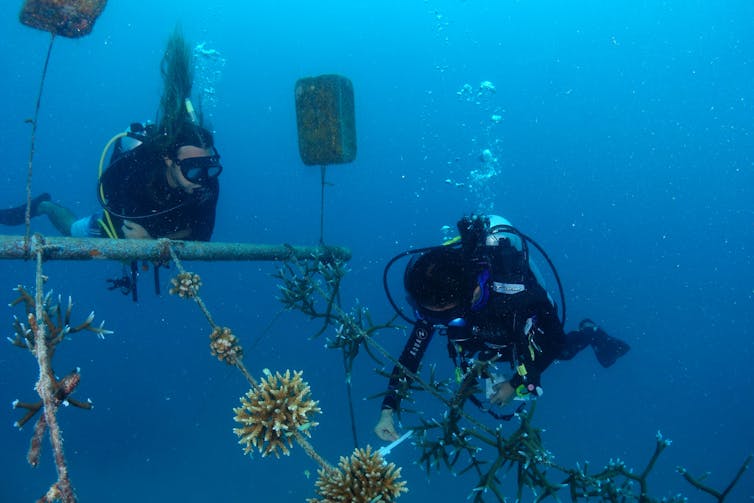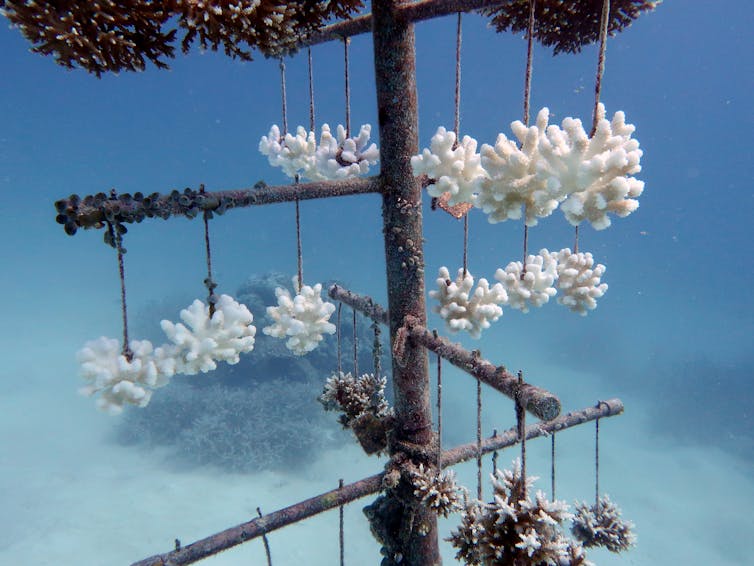 |
| Daytona, Florida, United States Shutterstock |
Thursday, 16 October 2025
Climate change - sea levels will rise even if the global temperature increase is only 1.5°C
Saturday, 12 April 2025
Climate change and the loss of coral reefs
Reality check: coral restoration won’t save the world’s reefs
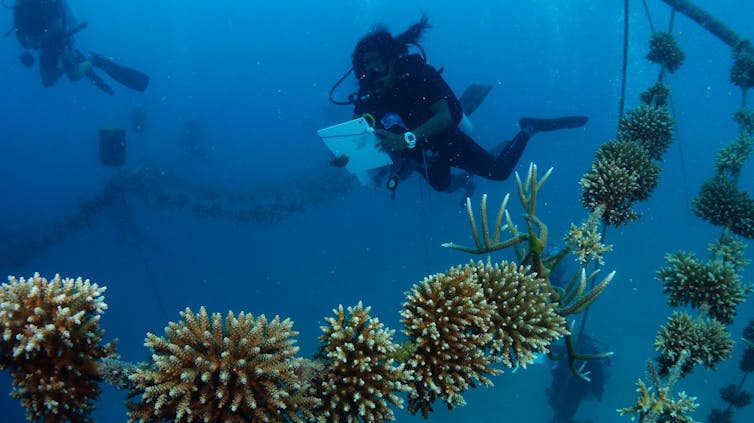
Coral reefs are much more than just a pretty place to visit. They are among the world’s richest ecosystems, hosting about a third of all marine species.
These reefs also directly benefit more than a billion people, providing livelihoods and food security, as well as protection from storms and coastal erosion.
Without coral reefs, the world would be a much poorer place. So when corals die or become damaged, many people try to restore them. But the enormity of the task is growing as the climate keeps warming.
In our new research, we examined the full extent of existing coral restoration projects worldwide. We looked at what drives their success or failure, and how much it would actually cost to restore what’s already been lost. Restoring the reefs we’ve already lost around the world could cost up to A$26 trillion.
Global losses
Sadly, coral reefs are suffering all over the world. Global warming and marine heatwaves are the main culprits. But overfishing and pollution make matters worse.
When sea temperatures climb above the seasonal average for sustained periods, corals can become bleached. They lose colour as they expel their symbiotic algae when stressed, revealing the white skeleton underneath. Severe bleaching can kill coral.
Coral bleaching and mass coral deaths are now commonplace. Last month, a massive warm-water plume bleached large areas of Ningaloo Reef on Australia’s northwest coast just as large sections of the northern Great Barrier Reef were bleaching on the northeast coast.
Since early 2023, mass coral bleaching has occurred in throughout the tropics and parts of the Indian Ocean.
Over the past 40 years, the extent of coral reefs has halved. As climate change continues, bleaching events and coral deaths will become more common. More than 90% of coral reefs are at risk of long-term degradation by the end of the century.
Direct intervention
Coral reef restoration can take many forms, including removing coral-eating species such as parrot fish, transferring coral spawn, or even manipulating the local community of microbes to improve coral survival.
But by far the most common type of restoration is “coral gardening”, where coral fragments grown in nurseries are transplanted back to the reef.
The problem is scale. Coral restoration can only be done successfully at a small scale. Most projects only operate over several hundred or a few thousand square metres. Compare that with nearly 12,000 square km of loss and degradation between 2009 and 2018. Restoration projects come nowhere near the scale needed to offset losses from climate change and other threats.
Sky-high costs
Coral restoration is expensive, ranging from around $10,000 to $226 million per hectare. The wide range reflects the variable costs of different techniques used, ease of access, and cost of labour. For example, coral gardening (coral fragments grown in nurseries transplanted back to the reef) is relatively cheap (median cost $558,000 per hectare) compared with seeding coral larvae (median $830,000 per hectare). Building artificial reefs can cost up to $226 million per hectare.
We estimated it would cost more than $1.6 billion to restore just 10% of degraded coral areas globally. This is using the lowest cost per hectare and assuming all restoration projects are successful.
Even our conservative estimate is four times more than the total investment in coral restoration over the past decade ($410 million).
But it’s reasonable to use the highest cost per hectare, given high failure rates, the need to use several techniques at the same site, and the great expense of working on remote reefs. Restoring 10% of degraded coral areas globally, at $226 million a hectare, would cost more than $26 trillion – almost ten times Australia’s annual GDP.
It is therefore financially impossible to tackle the ongoing loss of coral reefs with restoration, even if local projects can still provide some benefits.
Location, location, location
Our research also looked at what drives the choice of restoration sites. We found it depends mostly on how close a reef is to human settlements.
By itself, this isn’t necessarily a bad thing. But we also found restoration actions were more likely to occur in reefs already degraded by human activity and with fewer coral species.
This means we’re not necessarily targeting sites where restoration is most likely to succeed, or of greatest ecological importance.
Another limitation is coral gardening normally involves only a few coral species – the easiest to rear and transplant. While this can still increase coral cover, it does not restore coral diversity to the extent necessary for healthy, resilient ecosystems.
Measuring ‘success’
Another sad reality is that more than a third of all coral restoration efforts fail. The reasons why can include poor planning, unproven technologies, insufficient monitoring, and subsequent heatwaves.
Unfortunately, there’s no standard way to collect data or report on restoration projects. This makes it difficult – or impossible – to identify conditions leading to success, and reduces the pace of improvement.
Succeed now, fail later
Most coral transplants are monitored for less than 18 months. Even if they survive that period, there’s no guarantee they will last longer. The long-term success rate is unknown.
When we examined the likelihood of extreme heat events immediately following restoration and in coming decades, we found most restored sites had already experienced severe bleaching shortly after restoration. It will be difficult to find locations that will be spared from future global warming.
No substitute for climate action
Coral restoration has the potential to be a valuable tool in certain circumstances: when it promotes community engagement and addresses local needs. But it is not yet – and might never be – feasible to scale up sufficiently to have meaningful long-term positive effects on coral reef ecosystems.
This reality check should stimulate constructive debate about when and where restoration is worthwhile. Without stemming the pace and magnitude of climate change, we have little power to save coral reefs from massive losses over the coming century and beyond.
Other conservation approaches such as establishing, maintaining and enforcing marine protected areas, and improving water quality, could improve the chance a coral restoration project will work. These efforts could also support local human communities with incentives for conservation.
Reinforcing complementary strategies could therefore bolster ecosystem resilience, extending the reach and success of coral restoration projects.![]()
Corey J. A. Bradshaw, Matthew Flinders Professor of Global Ecology and Node Leader in the ARC Centre of Excellence for Indigenous and Environmental Histories and Futures, Flinders University; Clelia Mulà, PhD student in Marine Ecology, The University of Western Australia, and Giovanni Strona, Doctoral program supervisor, University of Helsinki
This article is republished from The Conversation under a Creative Commons license. Read the original article.
Thursday, 27 June 2024
Coral reefs in jeopardy
Devastating coral bleaching will be more common, start earlier and last longer unless we cut emissions
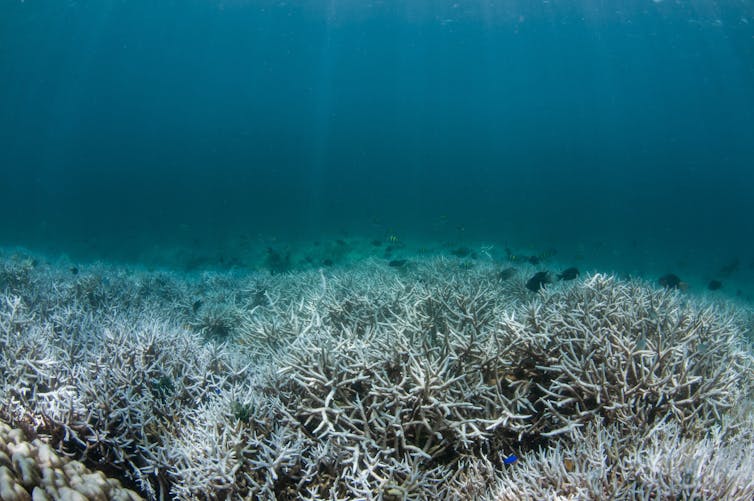
Coral bleaching is becoming much more common as a result of increasingly severe and frequent marine heatwaves. Four global mass bleaching events have happened since 1998. Two of these were in the past decade.
Unless greenhouse gas emissions are cut to slow global warming, our new research shows that, by 2080, coral bleaching will start in spring, rather than late summer. Some events will last into autumn. The Great Barrier Reef’s maximum annual heat stress will double by 2050 if emissions do not slow.
Marine heatwaves stress corals, which then expel the symbiotic algae living in their tissue. These corals are left white and weakened. While not all bleached corals die immediately, prolonged heat stress harms their health and reproduction.
Our research used daily data on sea surface temperatures (instead of monthly data that models typically use) and supercomputing to produce high-resolution projections of marine heatwaves. We showed the risk of coral bleaching will be greatest along the equator. That’s also where the most biodiverse coral reefs are found.
Coral reefs cover only 1% of our oceans, but host at least 25% of all marine species. More than half a billion people worldwide depend on coral reefs for food.
So coral reefs are vital for the health of the ocean and people. They are also among the ecosystems most at risk from climate change.
Longer bleaching season will hit spawning
The US National Oceanic and Atmospheric Administration monitors marine heatwaves globally. Seasonal coral bleaching alerts are based on this data. Predicting coral bleaching risk over entire decades has proved much more challenging.
Recent improvements in climate modelling now allow marine heatwaves and coral bleaching risks to be predicted with high accuracy. Using daily projections of heat stress from many global climate models, we show the severity and duration of coral bleaching will soon reach uncharted territory.
By mid-century coral bleaching is expected to start in spring for most of Earth’s reefs, rather than late summer as is typical today. In equatorial regions, corals will be at high risk of bleaching all year round by the end of the century.
In many regions, corals spawn only once a year. These spectacular mass spawning events happen in a single week following a full moon in spring.
By 2040, this spawning event could coincide with severe bleaching risk. This would greatly reduce their reproductive success, causing large-scale coral loss.

Equatorial regions most at risk
We show the future risk of severe coral bleaching is uneven globally.
The greatest risk is along the equator. Equatorial regions are home to the most biodiverse coral reefs, including conservation hotspots such as the Coral Triangle. To make matters worse, marine life in these regions is particularly vulnerable to accelerated climate change.
Many equatorial species are already living at temperatures near their upper tolerance. They also generally have low abilities to move to track shifting climates. This leaves them at high risk of extinction.
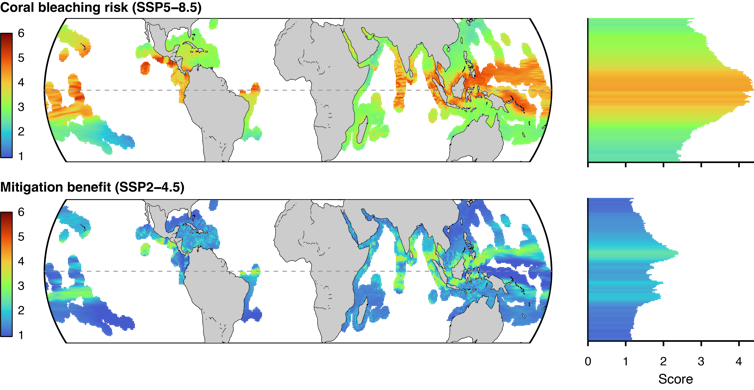
Our research shows equatorial regions are set to benefit least from efforts to curb emissions. We expect significant emission cuts will reduce the annual duration of severe bleaching conditions in all areas except these regions.
The projected highest climate impacts coincide with highest social reliance on coral reefs. This will challenge human populations that rely heavily on their local reefs for their livelihoods and nutrition.
Improving coral reef management
Our research identifies Earth’s reef regions that are at lowest risk of increased bleaching. This will help conservation managers and policymakers prioritise efforts to limit loss of coral reef biodiversity.
We predict much less risk of coral bleaching in regions such as the northern coasts of Venezuela and Colombia, Socotra Island (opposite the Gulf of Aden) and Alor Kecil in Indonesia. Seasonal upwellings occur here, bringing cooler water to the surface that’s likely to limit the severity of heatwaves.
Identifying these future havens for coral reefs will help maximise the success of coral conservation strategies such as assisted evolution, coral restoration or transplantation.
These strategies can help maintain healthy coral populations at local scales, particularly if used on reefs where future climate impacts will be lower. By pinpointing these havens, our research will strengthen coral conservation.
Our research includes a user-friendly web-based tool for mapping future coral bleaching. It will help pinpoint locations for effective management interventions.
Curbing greenhouse gas emissions is the main solution to reduce future climate impacts on corals. However, other strategies are also vital to maximise coral reefs’ adaptation to climate change.![]()
Camille Mellin, Senior Lecturer and ARC Future Fellow, School of Biological Sciences, University of Adelaide and Damien Fordham, Associate Professor of Global Change Ecology, University of Adelaide
This article is republished from The Conversation under a Creative Commons license. Read the original article.
Tuesday, 13 February 2024
The risk of ocean change and climate impact
Atlantic Ocean is headed for a tipping point − once melting glaciers shut down the Gulf Stream, we would see extreme climate change within decades, study shows
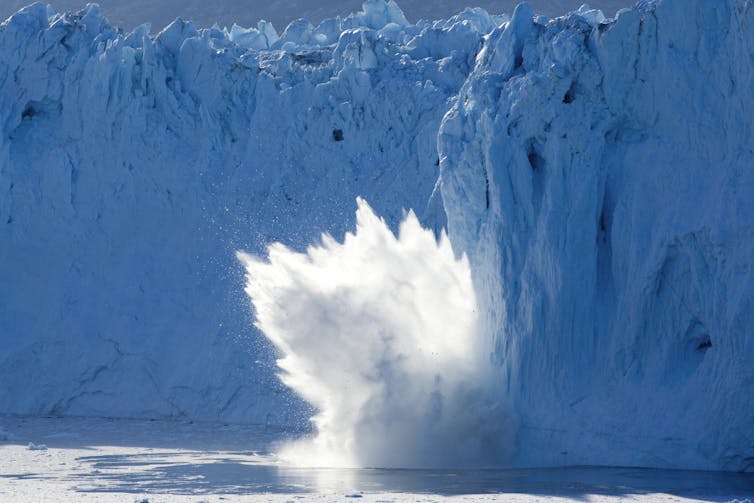
Superstorms, abrupt climate shifts and New York City frozen in ice. That’s how the blockbuster Hollywood movie “The Day After Tomorrow” depicted an abrupt shutdown of the Atlantic Ocean’s circulation and the catastrophic consequences.
While Hollywood’s vision was over the top, the 2004 movie raised a serious question: If global warming shuts down the Atlantic Meridional Overturning Circulation, which is crucial for carrying heat from the tropics to the northern latitudes, how abrupt and severe would the climate changes be?
Twenty years after the movie’s release, we know a lot more about the Atlantic Ocean’s circulation. Instruments deployed in the ocean starting in 2004 show that the Atlantic Ocean circulation has observably slowed over the past two decades, possibly to its weakest state in almost a millennium. Studies also suggest that the circulation has reached a dangerous tipping point in the past that sent it into a precipitous, unstoppable decline, and that it could hit that tipping point again as the planet warms and glaciers and ice sheets melt.
In a new study using the latest generation of Earth’s climate models, we simulated the flow of fresh water until the ocean circulation reached that tipping point.
The results showed that the circulation could fully shut down within a century of hitting the tipping point, and that it’s headed in that direction. If that happened, average temperatures would drop by several degrees in North America, parts of Asia and Europe, and people would see severe and cascading consequences around the world.
We also discovered a physics-based early warning signal that can alert the world when the Atlantic Ocean circulation is nearing its tipping point.
The ocean’s conveyor belt
Ocean currents are driven by winds, tides and water density differences.
In the Atlantic Ocean circulation, the relatively warm and salty surface water near the equator flows toward Greenland. During its journey it crosses the Caribbean Sea, loops up into the Gulf of Mexico, and then flows along the U.S. East Coast before crossing the Atlantic.
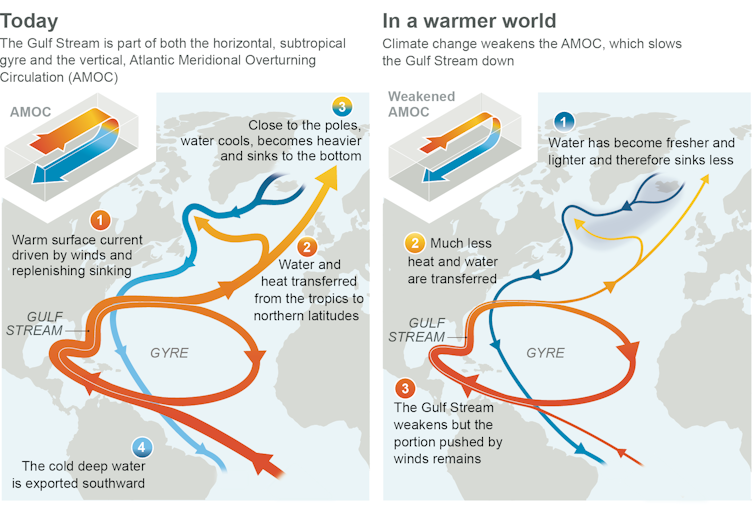
This current, also known as the Gulf Stream, brings heat to Europe. As it flows northward and cools, the water mass becomes heavier. By the time it reaches Greenland, it starts to sink and flow southward. The sinking of water near Greenland pulls water from elsewhere in the Atlantic Ocean and the cycle repeats, like a conveyor belt.
Too much fresh water from melting glaciers and the Greenland ice sheet can dilute the saltiness of the water, preventing it from sinking, and weaken this ocean conveyor belt. A weaker conveyor belt transports less heat northward and also enables less heavy water to reach Greenland, which further weakens the conveyor belt’s strength. Once it reaches the tipping point, it shuts down quickly.
What happens to the climate at the tipping point?
The existence of a tipping point was first noticed in an overly simplified model of the Atlantic Ocean circulation in the early 1960s. Today’s more detailed climate models indicate a continued slowing of the conveyor belt’s strength under climate change. However, an abrupt shutdown of the Atlantic Ocean circulation appeared to be absent in these climate models.
This is where our study comes in. We performed an experiment with a detailed climate model to find the tipping point for an abrupt shutdown by slowly increasing the input of fresh water.
We found that once it reaches the tipping point, the conveyor belt shuts down within 100 years. The heat transport toward the north is strongly reduced, leading to abrupt climate shifts.
The result: Dangerous cold in the North
Regions that are influenced by the Gulf Stream receive substantially less heat when the circulation stops. This cools the North American and European continents by a few degrees.
The European climate is much more influenced by the Gulf Stream than other regions. In our experiment, that meant parts of the continent changed at more than 5 degrees Fahrenheit (3 degrees Celsius) per decade – far faster than today’s global warming of about 0.36 F (0.2 C) per decade. We found that parts of Norway would experience temperature drops of more than 36 F (20 C). On the other hand, regions in the Southern Hemisphere would warm by a few degrees.
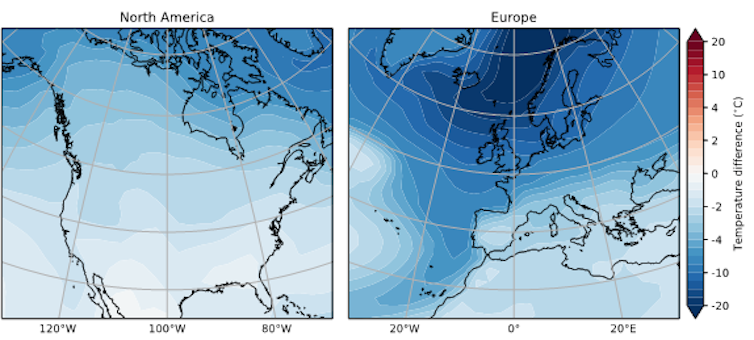
These temperature changes develop over about 100 years. That might seem like a long time, but on typical climate time scales, it is abrupt.
The conveyor belt shutting down would also affect sea level and precipitation patterns, which can push other ecosystems closer to their tipping points. For example, the Amazon rainforest is vulnerable to declining precipitation. If its forest ecosystem turned to grassland, the transition would release carbon to the atmosphere and result in the loss of a valuable carbon sink, further accelerating climate change.
The Atlantic circulation has slowed significantly in the distant past. During glacial periods when ice sheets that covered large parts of the planet were melting, the influx of fresh water slowed the Atlantic circulation, triggering huge climate fluctuations.
So, when will we see this tipping point?
The big question – when will the Atlantic circulation reach a tipping point – remains unanswered. Observations don’t go back far enough to provide a clear result. While a recent study suggested that the conveyor belt is rapidly approaching its tipping point, possibly within a few years, these statistical analyses made several assumptions that give rise to uncertainty.
Instead, we were able to develop a physics-based and observable early warning signal involving the salinity transport at the southern boundary of the Atlantic Ocean. Once a threshold is reached, the tipping point is likely to follow in one to four decades.
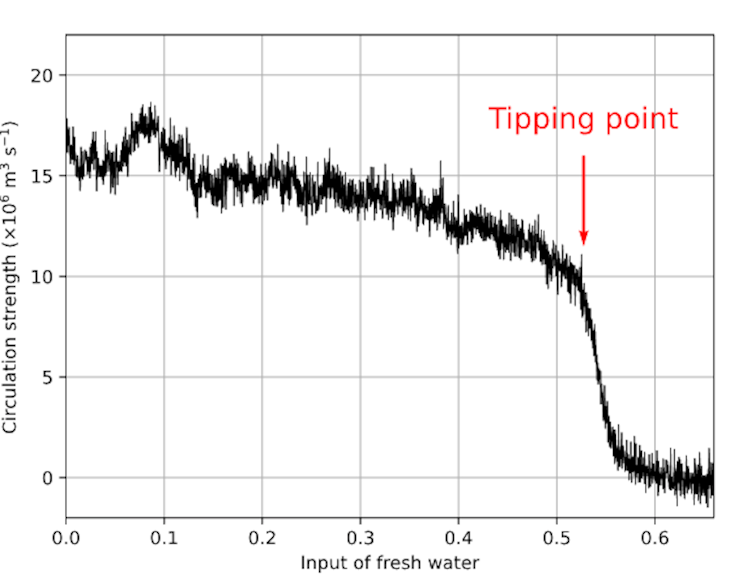
The climate impacts from our study underline the severity of such an abrupt conveyor belt collapse. The temperature, sea level and precipitation changes will severely affect society, and the climate shifts are unstoppable on human time scales.
It might seem counterintuitive to worry about extreme cold as the planet warms, but if the main Atlantic Ocean circulation shuts down from too much meltwater pouring in, that’s the risk ahead.
This article was updated on Feb. 11, 2024, to fix a typo: The experiment found temperatures in parts of Europe changed by more than 5 F per decade.![]()
René van Westen, Postdoctoral Researcher in Climate Physics, Utrecht University; Henk A. Dijkstra, Professor of Physics, Utrecht University, and Michael Kliphuis, Climate Model Specialist, Utrecht University
This article is republished from The Conversation under a Creative Commons license. Read the original article.
Saturday, 11 October 2014
The changing composition of the world's oceans - acidification
The link is below:
Thursday, 29 August 2013
Climate Change Insight: Impact of cooler oceans is only temporary
Tuesday, 23 July 2013
UNESCO's concern over the future of Australia's Great Barrier Reef
 |
| Bleached coral - Great Barrier Reef, Australia |
In relation to the Great Barrier Reef and Australia, the UN report specifically states:
b) halt the approval of coastal development projects that could individually or cumulatively impact on the property’s Oustanding Universal Value (OUV) and compromise the ongoing Strategic Assessment, and
c) ensure that the legislation protecting the property remains strong and adequate to maintain and enhance its OUV.
They further recommend that the Committee consider the Great Barrier Reef for inscription on the List of World Heritage in Danger at its 38th session in 2014 in the absence of a firm and demonstrable commitment on these priority issues by the State Party.
The Great Barrier Reef is one of the wonders of the world and the largest coral reef on the planet. The international recognition of serious threats to its' survival should galvanise further action domestically as warnings from local marine scientists appear to have been largely unsuccessful.
Saturday, 23 July 2011
The Great Barrier Reef and climate change
 |
| Great Barrier Reef, Queensland Australia |
Vol. 333 no. 6041 pp. 418-422
DOI: 10.1126/science.1204794

